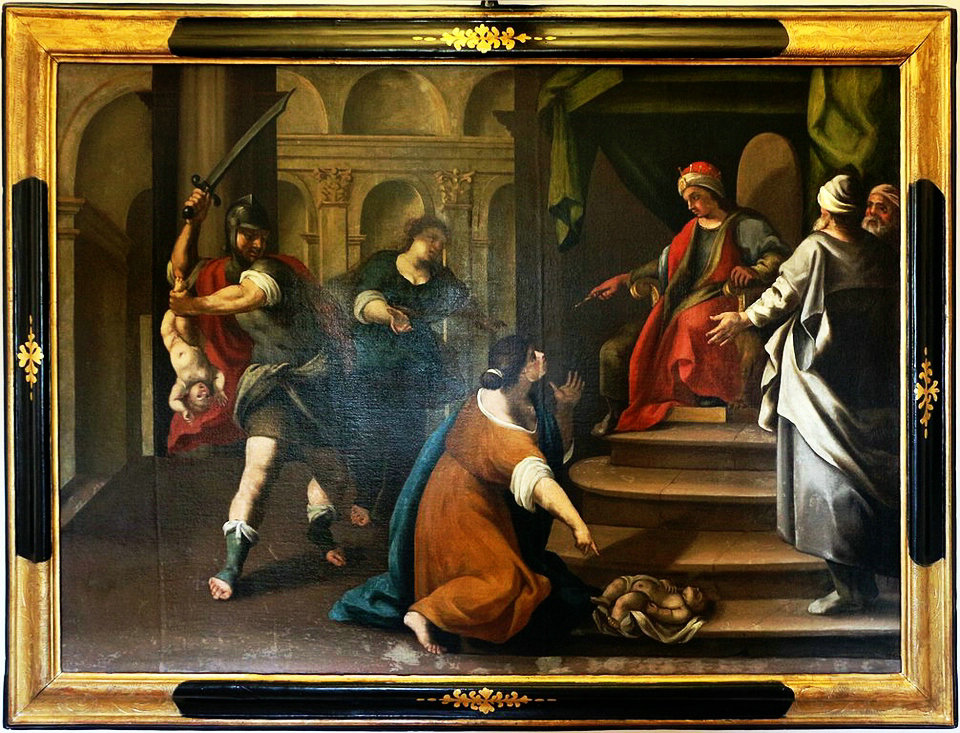Francesco Allegrini da Gubbio (1587–1663) was an Italian painter of the Baroque period. His children, Flaminio and Angelica Allegrini, were also painters. Angelica painted a canvas for the church of San Francesco, Gubbio.
He was admired as a battle painter. He was active in Rome, Genoa, Savona, and Naples. In Rome, he painted in the Vatican Loggias. He also painted in the church of San Marco, Rome, and the chapel of San Antonio in the church of Santi Cosma e Damiano. He painted for the Casa Durazzo in Genoa. In Savona he painted for the Palazzo Gavotti and the Savona Cathedral.
Biography
Born in Gubbio, he was also called Francesco da Gubbio. His father, Flaminio Allegrini da Cantiano, was also a painter. He studied under Giuseppe Cesari (Cavaliere D’Arpino), and later was helped by his sons in painting historical and religious paintings. A short biography is mentioned by Filippo Baldinucci.
Flaminio (1587-1666) had arrived in the city of the popes in 1601 and was soon entered into a workshop by Giuseppe Cesari, called the Cavalier d’Arpino; Francesco took his first steps in painting thanks to his father and later became a pupil of d’Arpino himself between about 1636-1638. The biographical and artistic story of the two Allegrini (in truth three, given that Anna Angelica, Francesco’s sister was a miniaturist; not much is known about her) takes place mainly between Cantiano – the country of origin of the father to whom the Allegrini always remained legacies, Rome and Gubbio – where the Allegrini were also property owners (but also Naples and Savona as far as Flaminio is concerned).
After 1640, the year of the death of d’Arpino, Francesco moved to the workshop by Pietro da Cortona(1596-1669) thanks to which he obtained some of his most important commissions in the capital. Its long activity is shared between Rome and Gubbio; his first Roman works are for Santa Maria dell’Umiltà (Saint Michael the Archangel, Saint Domenico of Soriano, around 1640) and for Palazzo Altieri (Room of Moses, 1644-50).
Between 1652-1655 it is certainly in Gubbio where he became a protégé of the bishop Alessandro Sperelli (1589-1672) who commissioned him the Chapel of the Sacrament in the cathedral. Between 1655, the year of his appointment as an academic of the Accademia di San Luca and 1660, he returned to Rome where he was engaged at Palazzo Pamphiljin Piazza Navona and in the convent of the Dominicans at the Minerva, formerly the palace of the Holy Office. From 1661 to 1681 he resides permanently in Gubbio, where “though declining, he continued for nearly two decades to dominate the field, venting himself, undisturbed, to frescoing vaults, domes and lunettes, and churning out altarpieces, like a small Cortona »(Marabottini, 1981).
The frescoes in the church of the Madonna del Prato (1676-77) consecrate him as the monopolizer of the local commissions and earned him the promotion to a major Umbrian frescoer of the 17th century. The painting San Girolamo between Sant’Antonio Abate and a Holy Pope(Circa 1681) preserved in the collegiate church of Cantiano seems to be his last work, realized before the final return to Rome, where he died in 1684.
Starting from the biography of Francis written by P. Orlandi(1704) «the erroneous reconstructions of his life have been different, even going so far as to hypothesize that the painter had two artist sons, Flaminio (known as junior) and Angelica, a totally unfounded circumstance.
The research on the artistic vicissitudes of father and son turned out to be quite problematic since the biographical information of one often merged into the life of the other; the logical consequence of this was the exchange that often took place between the corpus of the two painters and so to Francesco, since he was better known, a series of works by the parent were attributed “(Nocella 2007). Recent studies have finally allowed to better delineate the artistic personalities of Allegrini and shed light on the catalog of both.
Works
Decoration of the Palazzo Durazzo in Genoa.
… from Palazzo Pamphili in Rome (1650 approx).
… of the Casino of Porta S. Pancrazio
… churches of Saints Cosma and Damiano (frescoes of the history of Saint Alexander)
… of San Pietro in Montorio and S. Maria dell’Umiltà (Saint Michael chasing rebellious angels).
Frescoes of the cupola of the sacrament of the Dome of Gubbio.
Frescoes of Paradise Church of Madonna dei Bianchi in Gubbio.
Frescoes of two chapels of the Savona cathedral including that of the Gavotti family
Three altarpieces of the altar of the Capuchin church in Savona.
Vatican lodges (with his son Flaminio).
Woman lying, drawing, Museum of Fine Arts, Rennes.
Coronation of Thorns, drawing, Museum of Fine Arts, Rennes.
The Return of the Prodigal Son, drawing, Museum of Fine Arts, Rennes.
Landscape, drawing, Museum of Fine Arts, Rennes.
Aeneas and the Sibyl on the boat of Charon around 1650.
Source from Wikipedia
